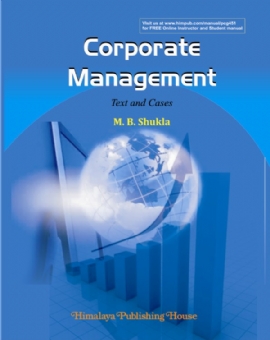The topics in the text are covered from the perspective of a person who wishes to learn about the corporate tax planning of a growth oriented business. However, it is important that managers also understand corporate tax planning developments on an overall macroeconomic level. Such an understanding enables managers to anticipate economic changes and adjust to what they expect to occur. Of late, the international financial developments that are happening are nothing short of spectacular. For example, new markets and instruments are emerging at a frantic pace that at times has been so volatile, that they grab headlines in the financial news. Great fortunes have been made and lost due to the compounded complexities of the taxation laws. It is therefore necessary that these are understood and advance tax planning is adopted.
It is also heartening and encouraging to note that Utkal University, Sambalpur, Bhubaneswar and Ravenshaw University have included Corporate Tax Planning in their B.Com. (Hons.) curriculum.
The book is divided into five units covering certain terms, Corporate Tax Planning concepts and various tax planning devices, which will have impact on decision making.
An introduction to the structure of the Corporate Tax Planning, meaning, objectives, types and factors on which Tax Planning is done is covered in Unit 1. The unit also covers Corporate Tax in India including types of companies, residential status of companies, tax incidence, tax liability and minimum alternate tax and additional tax on distributed profits.
Unit 2 explains Tax Planning with reference to: (i) Setting up new business — locational aspect, nature of business, form of organization; (ii) Financial Management decisions and (iii) Sale of scientific research assets.
Tax Planning with reference to: (i) managerial decisions such as buying out of borrowed funds or from own funds, purchase vs. leasing / hire, make or buy, epairs / renewal / renovation, etc., (ii) employees’ remuneration, (iii) receipt of insurance compensation and (iv) distribution of assets at the time of liquidation, are covered in Unit 3.
Unit 4 deals with Tax liability in respect of non-residents, relief for double taxation, computation of arms length prices in case of international transactions and Advance Ruling and Advance Pricing agreements.
Unit 5 explains the following in connection with business restructuring: (i) tax provisions relating to amalgamation, demerger, slump sale of companies, (ii) conversion of sole proprietary concern/partnership firm into company, and (iii) conversion of company into LLP and (iv) transfer of assets between holding company and subsidiary company so that relevant concessions can be availed through proper tax planning.
Contents –
UNIT 1: Introduction to Corporate Tax Planning
UNIT 2: Tax Planning – 1
UNIT 3: Tax Planning – 2
UNIT 4: Special Provisions Relating to Non-Residents
UNIT 5: Tax Planning with Reference to Business Restructuring







